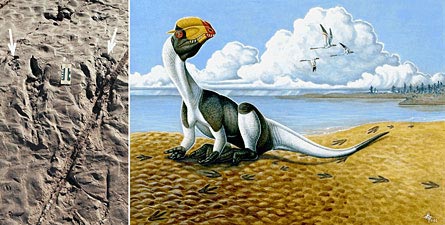Latest Palaeontological Research helps with Classroom Exercise
A few weeks ago, team members at Everything Dinosaur reported on the research published by a team of American scientists who had studied the best preserved hand prints of a theropod dinosaur. Theropod dinosaurs such as Megalosaurus, Allosaurus and Dilong were bipedal. This means that they walked upright on their hind legs. Scientists had speculated how these animals would have used their hands and what movement they would have had with their forelimbs. A lot can be determined by studying the fossilised arm and hand bones of these particular dinosaurs, but no decent, well-preserved “hand prints” of such animals had ever been found.
Dinosaur “Hand Prints”
The study of a dinosaur trackway, left in mudstone has revealed that dinosaurs had hands that were not suitable for walking upon very early in their evolution. In a report published in the online palaeontological journal PLos ONE, a U.S. based team have concluded that the fossil hand-prints, perhaps the best theropod hand-prints discovered to date, indicate that these dinosaurs abandoned the use of their forelimbs as legs early in their evolutionary development.
The lead author, Andrew R. C. Milner of the St George Dinosaur Discovery Site at Johnson Farm in Utah, stated that due to the disproportionately small forelimbs of most theropods, trace fossils of them as they rested on the ground are extremely rare. Only a few other examples of theropod hand-prints are known, but the discovery of a wonderfully well-preserved set of impressions in 2004, have enabled scientists to shed more light on the range of movement of dinosaur hands and arms.
Dinosaur Trace Fossils
Vertebrate palaeontologist Milner and his colleagues describe in the paper, a clear set of 5 cm deep impressions preserved amongst hundreds of other trace fossils in the sediment that has been dated to the Early Jurassic (Sinemurian faunal stage), approximately 198 million years ago. The rock preserves trace fossils of worm borings, tracks made by crabs as well as body fossils of fish. The sediment represents a part of a shoreline adjacent to an ancient lake (known as Lake Dixie). The water level seems to have altered and as a result the sediment shows signs that the water levels fell and the muddy sand cracked and dried in the sun.
A theropod dinosaur left a remarkable trackway, on this shoreline, it stopped and sat down, perhaps to rest for a while. As it rested it put its hand’s on the ground and these left impressions (left manus and right manus). There is even the marks in the fossilised trackway that show where the base of the tail was rested on the ground.
To read the article in full: Dinosaur Hand-print Reveals Link to Birds.
An Artist’s Impression of the Theropod Resting and Trackway Picture

Picture credit: H. K. Luterman of Cedar City, Utah
Everything Dinosaur, is always keen to build in new ideas and scientific developments into its teaching programmes so we combined the research work carried out on these remarkable trackways with an experiment with school children to see if dinosaurs and people has the same range of movement in their hands and arms. We term this teaching exercise, part of our range of classroom activities “the palms down activity”, but many of my colleagues prefer the more intriguing title – can dinosaurs juggle?
Dinosaur Hands
As well as showing various fossils with the class, we run an exercise to test how we place our hands when we are resting. By splitting the class into groups and appointing a student to supervise the exercise for each group we can get the entire class to repose with their hands in a relaxed, comfortable position. By studying how we; H. sapiens rest and comparing our resting position with that of a theropod dinosaur we can see differences in how we use our arms and hands compared to a dinosaur.
We carried out this experiment with Year 6 students at Barnfields Primary School in Stafford (England). The results, were as we predicted with most of these 10-11 years old pupils resting with their hands on the table palms down. This is a comfortable position for our hands, a very different pose to that of a theropod dinosaur. If the fossil trackway evidence from Utah proves to be conclusive, theropod dinosaurs rested with their palms facing in a more upwards direction.
Barnfields Primary School Children “Hands Up” Exercise
Picture credit: Everything Dinosaur
Pupils with their Hands in a Natural Resting Position
Picture credit: Everything Dinosaur
(Our thanks to the Barnfield Primary School, the teachers, parents and pupils for giving us permission to publish these photographs).
The pictures show that the majority of children, when unprompted, placed their hands palms down, interesting also to note the tendency to splay the fingers out, again in response to no prompting. We were then able to compare the student’s reaction to the fossil trackways and establish differences between our hands and those of a dinosaur.
Teachers and teaching assistants could develop this exercise by plotting the results on a simple bar chart or by introducing concepts of theory testing or describing events. The peculiar shaped object in the top right had section of the second photograph is actually a fossil, one of the many exhibits that we hand round in class. It is a fossil of a Woolly Mammoth’s tooth. Here at Everything Dinosaur, we have developed a number of ideas based around delivering a practical demonstration of real palaeontology – all based around the National Curriculum. For example, in our lesson plan for this exercise we cover concepts such as “make comparisons and identify patterns – N.C. KS2 SC1 2i” and ” how animals in a habitat are suited to their environment – N.C. KS2 SC1 5c”.
The exercise certainly proved very popular with the pupils and it did demonstrate our ability to pronate our forelimbs (twist our arms), a skill inherited from our tree climbing ancestors, and from the evidence presented here, we humans seem to have a greater range of arm movement than a theropod dinosaur. So, we can conclude that dinosaurs probably couldn’t juggle.
To view the range of dinosaur and prehistoric animal themed gifts approved by the teaching team at Everything Dinosaur: Dinosaur Toys and Gifts.








Leave A Comment